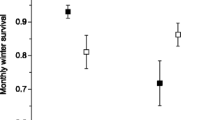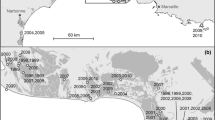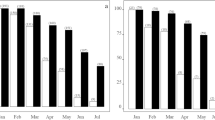Abstract
Animals competing for resources follow a general rule for which prior residents usually win contests over intruders. This prior residence effect might arise because animals possess a genetically fixed convention so that ‘residents always win’ (i.e. an uncorrelated asymmetry), because residents have a higher resource holding power (RHP) than intruders or because residents have a higher motivation to defend territories (i.e. pay-off asymmetry). The discrimination between these different hypotheses, though, has proven to be difficult. Eurasian siskins (Spinus spinus) provide us with an adequate opportunity to test for the effect of RHP on the prior residence effect. Siskins show two different strategies while in the wintering grounds: residents remain for several weeks on a given location while transients continuously move and residents are dominant over transients. The black bib area of male siskins signals their RHP. In this study, we compared the black bib area of a large sample of male resident and transient siskins and we found no differences between the two subpopulations. Hence, residence status in this species is not related to black bib size, which is a good proxy for RHP. Our results support the view that asymmetries in RHP are not required to explain the prior residence effect. We discuss the important implications that it has on the evolution of partial migration.

Similar content being viewed by others
References
Alcock J (2009) Animal behavior: an evolutionary approach. Sinauer Associates, Inc, Sunderland
Brodersen J, Chapman BB, Nilsson PA, Skov C, Hanson LA, Brönmark C (2014) Fixed and flexible: coexistence of obligate and facultative migratory strategies in a freshwater fish. PLoS ONE 9:e90294
Cristol DA, Nolan V Jr, Ketterson ED (1990) Effect of prior residence on dominance status of dark-eyed juncos, Junco hyemalis. Anim Behav 40:580–586
Domènech J, Senar JC (1997) Trapping methods can bias age ratio in samples of passerine populations. Bird Study 44:348–354
Forstmeier W (2002) Benefits of early arrival at breeding grounds vary between males. J Anim Ecol 71:1–9
Hake M (1996) Fattening strategies in dominance-structured greenfinch (Carduelis chloris) flocks in winter. Behav Ecol Sociobiol 39:71–76
Kokko H (2011) Directions in modelling partial migration: how adaptation can cause a population decline and why the rules of territory acquisition matter. Oikos 120:1826–1837
Kokko H, López-Sepulcre A, Morrell LJ (2006) From hawks and doves to self-consistent games of territorial behavior. Am Nat 167:901–912
Lundberg P (1985) Dominance behaviour, body weight and fat variations, and partial migration in European blackbirds Turdus merula. Behav Ecol Sociobiol 17:185–189
Mateos-González F, Senar JC (2012) Melanin-based trait predicts individual exploratory behaviour in siskins, Carduelis spinus. Anim Behav 83:229–232
Maynard Smith J, Parker GA (1976) The logic of asymmetric contests. Anim Behav 24:159–175
Mueller JC, Pulido F, Kempenaers B (2011) Identification of a gene associated with avian migratory behaviour. Proc R Soc Lond B 278:2848–2856
Nijman V, Heuts BA (2000) Effect of environmental enrichment upon resource holding power in fish in prior residence situations. Behav Process 49:77–83
Pascual J, Senar JC (2015) Resident but not transient Eurasian Siskins reduce body mass to increasing predation risk: a natural experiment. J Ornithol 156:451–456
Pascual J, Senar JC, Domènech J (2014) Are the costs of site unfamiliarity compensated with vigilance? A field test in Eurasian siskins. Ethology 120:1–13
Pilastro A, Bertorelle G, Marin G (1995) Winter fattening strategies of two passerine species: environmental and social influences. J Avian Biol 26:25–32
Piper WH, Wiley RH (1990) The relationship between social dominance, subcutaneous fat, and annual survival in wintering white-throated sparrows (Zonotrichia albicollis). Behav Ecol Sociobiol 26:201–208
Pryke SR, Andersson S (2003) Carotenoid-based epaulettes reveal male competitive ability: experiments with resident and floater red-shouldered widowbirds. Anim Behav 66:217–224
Réale D, Reader SM, Sol D, McDougall PT, Dingemanse NJ (2007) Integrating animal temperament within ecology and evolution. Biol Rev 82:291–318
Sandell M, Smith H (1991) Dominance, prior occupancy, and winter residency in the great tit (Parus major). Behav Ecol Sociobiol 29:147–152
Senar JC, Camerino M (1998) Status signalling and the ability to recognize dominants: an experiment with siskins (Carduelis spinus). Proc R Soc Lond B 265:1515–1520
Senar JC, Camerino M, Metcalfe NB (1989) Agonistic interactions in siskin flocks: why are dominants sometimes subordinate? Behav Ecol Sociobiol 25:141–145
Senar JC, Camerino M, Metcalfe NB (1990a) Familiarity breeds tolerance: the development of social stability in flocking siskins (Carduelis spinus). Ethology 85:13–24
Senar JC, Copete JL, Metcalfe NB (1990b) Dominance relationships between resident and transient wintering siskins. Ornis Scand 21:129–132
Senar JC, Burton PJK, Metcalfe NB (1992) Variation in the nomadic tendency of a wintering finch Carduelis spinus and its relationship with body condition. Ornis Scand 23:63–72
Senar JC, Camerino M, Copete JL, Metcalfe NB (1993) Variation in black bib of the Eurasian siskin (Carduelis spinus) and its role as a reliable badge of dominance. Auk 110:924–927
Senar JC, Lleonart J, Metcalfe NB (1994) Wing-shape variation between resident and transient wintering siskins Carduelis spinus. J Avian Biol 25:50–54
Senar JC, Camerino M, Uribe F (2001) Body mass regulation in resident and transient wintering siskins Carduelis spinus. Etología 9:47–52
Svensson L (1992) Identification guide to European passerines. L. Svensson, Stockholm
Verhulst S, Hogstad O (1996) Social dominance and energy reserves in flocks of Willow Tits. J Avian Biol 27:203–208
Witter MS, Cuthill IC (1993) The ecological costs of avian fat storage. Phil Trans Roy Soc Lond B 340:73–92
Witter MS, Swaddle JP (1995) Dominance, competition, and energetic reserves in the European starling, Sturnus vulgaris. Behav Ecol 6:343–348
Acknowledgments
We thank Jordi Domènech, David Boné, Anna Serra, Esther Vilamajó and Miquel Boix for the field assistance, and Nuria Mallén and Mª Luisa Arroyo for the laboratory assistance. We also thank the independent reviewers for their useful comments. This paper is a contribution to project CGL 2012-38262 from Ministerio de Ciencia e Innovación and Ministerio de Economía y Competitividad.
Ethical standards
The experiments of the present study comply with the current laws of Spain. Siskins were caught by expert bird ringers with the authorization of the Ornithological Catalan Institute and the Catalan Government.
Author information
Authors and Affiliations
Corresponding author
Additional information
Communicated by A. Pilastro
Rights and permissions
About this article
Cite this article
Senar, J.C., Pascual, J. Prior residence effect in wintering male Eurasian siskins is not related to resource holding power. Behav Ecol Sociobiol 69, 1113–1118 (2015). https://doi.org/10.1007/s00265-015-1923-z
Received:
Revised:
Accepted:
Published:
Issue Date:
DOI: https://doi.org/10.1007/s00265-015-1923-z




